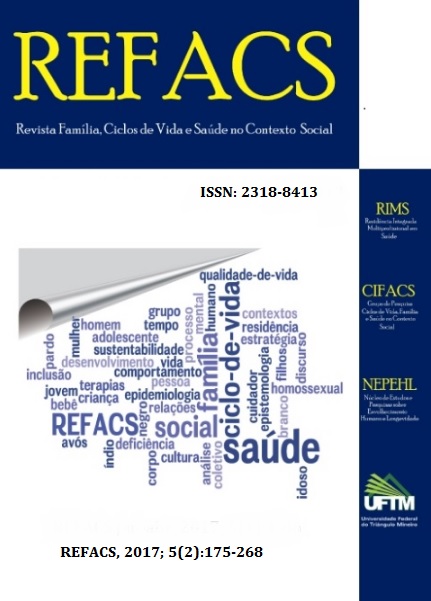Percepções dos acompanhantes de pacientes em estado de terminalidade
DOI:
https://doi.org/10.18554/refacs.v5i2.1790Palavras-chave:
Cuidados paliativos na terminalidade da vida, Família, Humanização da assistênciaResumo
Este estudo teve como objetivo descrever e analisar as percepções dos acompanhantes de pacientes em estado de terminalidade num hospital público. Foi utilizada a abordagem quantitativa, tendo como sujeitos 104 acompanhantes de pacientes terminais internados no Pronto Socorro e Unidade de Terapia Intensiva. A coleta de dados realizou-se através de entrevistas com um roteiro semiestruturado. Os resultados demonstraram que 36,54% dos acompanhantes não reconheciam o quadro de impossibilidade de cura, seguidos de 16,35% indecisos, totalizando cerca de 52,89% sem conhecimento do prognóstico do paciente. O prolongamento da vida do paciente incurável é apoiado por 58,65% dos pesquisados. Os acompanhantes de pacientes terminais necessitam de maiores esclarecimentos sobre a irreversibilidade do quadro clínico. Os serviços de saúde direcionados aos pacientes terminais devem incluir os acompanhantes e familiares em seus planos de atenção e cuidado.
Referências
Almeida SCT. A morte faz falar. Otimizar a comunicação em cuidados paliativos para otimizar os cuidados em fim de vida. [dissertação]. [Lisboa]: Faculdade de Psicologia e Ciências da Educação. Universidade de Lisboa; 2008.
Kovács MJ. Sofrimento psicológico de pacientes com câncer avançado em programas de cuidados paliativos. Bol Psicol. 1998; 48(109):25- 47.
Araujo JA, Leitão EMP. A comunicação de más notícias: mentira piedosa ou sinceridade cuidadosa. Rev Hosp Univ Pedro Ernesto. 2012; 11(2):58-62.
Carvalho VA. Cuidados com o cuidador. In: Pessini L, Bertachini L. Humanização e cuidados paliativos. 2ed. São Paulo: Loyola; 2004. 305-319.
Inocenti A, Rodrigues IG, Miasso AI. Vivências e sentimentos do cuidador familiar do paciente oncológico em cuidados paliativos. Rev Eletr Enferm [Internet]. 2009; [citado em 22 de jan 2016] 11(4):858-65. Disponível em: https://www.fen.ufg.br/fen_revista/v11/n4/pdf/v11n4a11.pdf
World Health Organization. National cancer control programmes: policies and managerial guidelines. 2nd ed. Geneva: Who; 2002.
Almaraz MJ, Aldasoro E, Sobradillo N. Estudio de satisfacción y de identificación de factores de la atención hospitalaria que los familiares de personas fallecidas consideran importantes en la fase final de la vida. Vitoria-Gasteiz (País Basco): Departamento de Sanidad, Gobierno Vasco; 2007. Osteba. Informe de evaluación: D-06-04.
Laidsaar-Powell RC, Butow PN, Bu S, Charles C, Gafni A, Lam WW, et al. Physician-patient-companion communication and decision-making: a systematic review of triadic medical consultations. Patient Educ Couns. 2013; 91(1):3-13.
Taquemori LY, Sera CTN. Interface Intrínseca: equipe multiprofissional. In: Oliveira RA, organizador. Cuidado paliativo. São Paulo: Cremesp; 2008. p. 55.
Chernicharo IM, Ferreira MA. Sentidos do cuidado com o idoso hospitalizado na perspectiva dos acompanhantes. Esc Anna Nery Enferm. [Internet]. 2015 [citado em 22 jan 2016]; 19(1): 80-85. Disponível em: http://www.scielo.br/pdf/ean/v19n1/1414-8145-ean-19-01-0080.pdf.
Domingues GR, Alves KO, Carmo PHS, Galvão SS, Teixeira SS, Baldoino EF. A atuação do psicólogo no tratamento de pacientes terminais e seus familiares. Psicol Hosp. (São Paulo). 2013; 11(1):2-24.
Ordem dos Enfermeiros. Regulamento das competências comuns do enfermeiro generalista. Lisboa: Ordem dos Enfermeiros; 2012. Disponível em: http://www.ordemenfermeiros.pt/publicacoes/Documents/divulgar%20%20regulamento%20do%20perfil_VF.pdf.
Geovanini F, Braz M. Conflitos éticos na comunicação de más notícias em oncologia. Rev Bioét. [Internet]. 2013 [citado em 22 jan 2016]; 21(3):455-62. Disponível em: http://www.scielo.br/pdf/bioet/v21n3/a10v21n3.pdf.
Anjos ACY, Zago MMF. Ressignificação da vida do cuidador do paciente idoso com cancer. Rev Bras Enferm. 2014; 67(5):752-8.
Pires LCB, Vargas MAO, Vieira RW, Ramos FRS, Ferrazzo S, Bitenco JVOV. Relação entre equipe de enfermagem e família de pessoas em cuidados paliativos. Enferm Foco. 2013; 4(1):54-7.
Hennemann-Krause L. Ainda que não se possa curar, sempre é possível cuidar. Rev Hosp Univ Pedro Ernesto. 2012; 11(2):18-25
Marques L, Matos MDF, Lourenço J, Amendoeira J. Cuidar da pessoa para uma boa morte, na comunidade. Rev UIIPS. 2015; 3(5):12-23.
Andrades M, Kausar S, Ambreen A. Role and influence of the patient's companion in family medicine consultations: “The Patient's Perspective”. J Family Med Prim Care. 2013; 2(3):283-7.
Downloads
Publicado
Edição
Seção
Licença
Este trabalho está licenciado sob uma licença Creative Commons Attribution-NonCommercial 4.0 International License.



